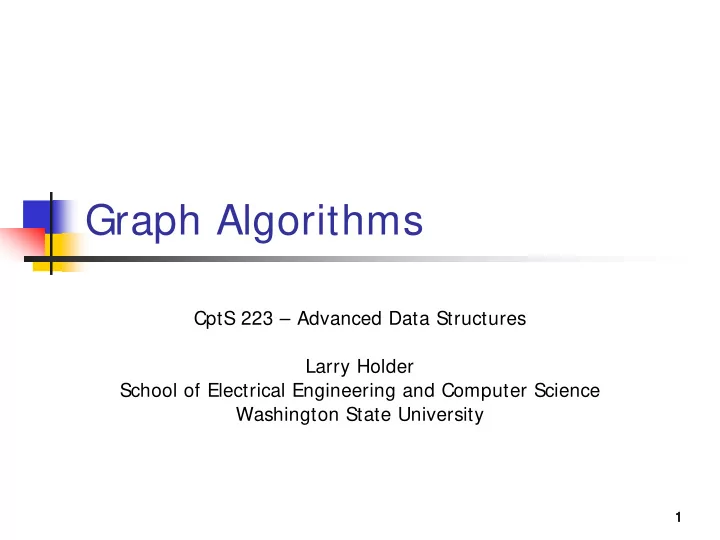

Graph Algorithms CptS 223 – Advanced Data Structures Larry Holder School of Electrical Engineering and Computer Science Washington State University 1
Network Flow How much freight can flow from Seattle to Pullman? From Seattle to Chicago? From Washington to Illinois? 2
Network Flow Approach � Let the waypoints (cities, distribution centers) be vertices in a graph � Let the routes (roads, rails, waterways, airways) between waypoints be directed edges in the graph � Each edge has a weight representing the route’s capacity � Choose a starting point s and an ending point t � Determine the maximum rate (e.g., tons/hour) at which we can flow freight from point s to point t � Without the freight piling up anywhere along the way 3
Network Flow Applications � Freight flow through shipping networks � Fluid flow through a network of pipes � Data flow (bandwidth) through computer networks � Nutrient flow through food networks � Electricity flow through power distribution systems � People flow through mass transportation systems � Traffic flow through a city 4
Network Flow Problem � Given � Directed graph G= (V,E) with edge capacities c v,w � Source vertex s � Sink vertex t � Constraints � Flow along directed edge (v,w) cannot exceed capacity c v,w � At every vertex (except s and t) the total flow coming in must equal the total flow going out � Find � Maximum amount of flow from s to t 5
Network Flow � Example network graph (left) and its maximum flow (right) 6
Maximum Flow Algorithm � Flow graph G f � Indicates the amount of flow on each edge in the network � Residual graph G r � Indicates how much more flow can be added to each edge in the network � Residual capacity = (capacity – current flow) � Edges with zero residual capacity removed � Augmenting path � Path from s to t in G r � Edge with smallest residual capacity in the path indicates amount by which flow can increase along path 7
Maximum Flow Algorithm � Example Augmenting Path (s,b,d,t) Network Graph Initial Flow Graph Residual Graph 8
Maximum Flow Algorithm � While an augmenting path exists in G r � Choose one � Flow increase FI = minimum residual capacity along augmenting path � Increase flows along augmenting path in flow graph G f by FI � Update residual graph G r 9
Maximum Flow Algorithm � Example (cont.) after choosing (s,b,d,t) Augmenting Path (s,a,c,t) Network Graph Residual Graph Flow Graph (f=2) 10
Maximum Flow Algorithm � Example (cont.) after choosing (s,a,c,t) Augmenting Path (s,a,d,t) Network Graph Residual Graph Flow Graph (f=4) 11
Maximum Flow Algorithm � Example (cont.) after choosing (s,a,d,t) Network Graph Residual Graph Flow Graph (f=5) Terminates with maximum flow f = 5. 12
Maximum Flow Algorithm � Problem: Suppose we chose augmenting path (s,a,d,t) first Network Graph Residual Graph Flow Graph (f=3) Terminates with flow f = 3. 13
Maximum Flow Algorithm � Solution � Indicate potential for back flow in residual graph � I.e., allow another augmenting path to undo some of the flow used by a previous augmenting path Network Graph Residual Graph Flow Graph (f=3) 14
Maximum Flow Algorithm � Example (cont.) after choosing (s,b,d,a,c,t) Network Graph Residual Graph Flow Graph (f=5) Terminates with maximum flow f = 5. 15
Maximum Flow Algorithm � Analysis � If edge capacities are rational numbers, then this algorithm always terminates with maximum flow � If capacities are integers and maximum flow is f, then running time is O(f · |E|) � Flow always increases by at least 1 with each augmenting path � Augmenting path can be found in O(|E|) time using unweighted shortest-path algorithm � Problem: Can be slow for large f 16
Maximum Flow Algorithm � Variants � Always choose augmenting path allowing largest increase in flow � O(|E|) calls to O(|E| log |V|) Dijkstra algorithm � Running time O(|E| 2 log |V|) � Always choose the augmenting path with the fewest edges (unweighted shortest path) � At most O(|E||V|) augmenting steps, each costing O(|E|) for call to BFS � Running time O(|E| 2 |V|) 17
Network Flow � Variants � Multiple sources and sinks � Create super-source with infinite-capacity links to each source � Create super-sink with infinite-capacity links from each sink � Min-cost flow � Each edge has capacity and cost � Find maximum flow with minimum cost � No known fast solution 18
Network Flow � Important algorithm with numerous practical applications � Running time depends on method for finding augmenting path � BFS: O(|E| 2 |V|) � Dijkstra: O(|E| 2 log |V|) 19
Recommend
More recommend